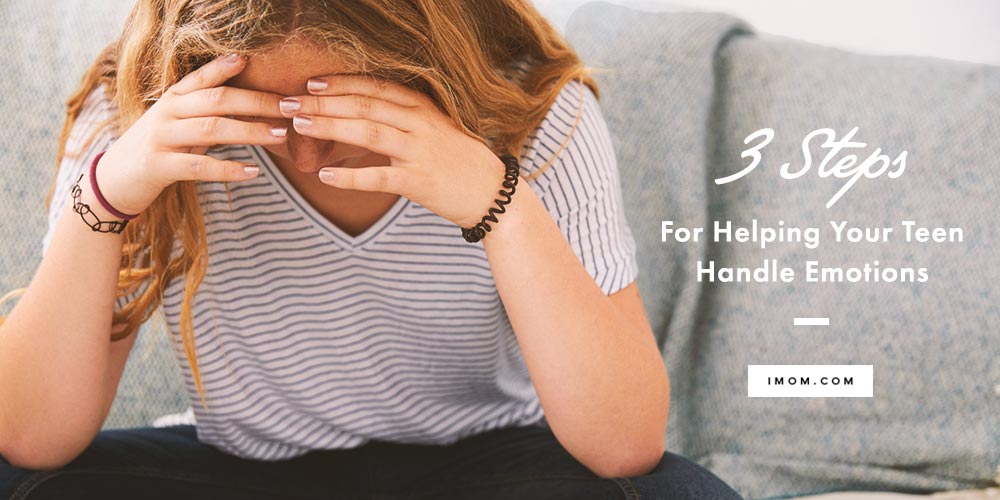We talk about emotions and emotional boundaries with our girls frequently. It’s a side effect of being married to a professional counselor. So, I shouldn’t have been surprised when I heard our 17-year-old start recycling a sentence we’ve used with her: “I don’t like the way you’re talking to me. I feel disrespected.”
I loved hearing her make it clear that someone had crossed an emotional boundary with her, except for one thing—it was me. I had stepped over that boundary, and her emotional crossing guard calmly let me know. Ouch. Learning to set emotional boundaries is important during the teen years when kids search to find their identity. Those boundaries help teens understand what is and isn’t theirs to feel or fix. Here are 6 things to teach your daughter about setting her own emotional boundaries.
1. You’re in charge of your emotions and reactions.
No one can “make” you feel or react a certain way. Your emotions are your own, and you can choose how to respond to them and express them to others. Your daughter will need time and your coaching to practice this boundary.
Start by leading her to recognize and label her emotions and digging into why she feels them. “I feel this because of that.” Help your daughter identify emotional patterns or triggers. While external factors—such as other people or circumstances—can influence her emotions, she has the power to choose how to respond. She isn’t a puppet emotionally controlled by someone else. She holds her own strings and takes full responsibility for how she responds and expresses her emotions to others. By the way, teens with ADHD may need additional strategies to help set boundaries and respect the boundaries of others.
2. You’re NOT responsible for the emotions and reactions of someone else.
Just as no one can “make” your daughter feel or react a certain way, she can’t force someone to feel or react a certain way either. Yes, she can influence another person, but she can’t control the emotions of someone else. Embracing this truth can give her confidence in respectfully expressing her own emotions without the burden of trying to control someone she can’t control. She can acknowledge someone’s response by saying something like “I can see that you’re (sad, hurt, angry, disappointed…) by what I said.”
Just as no one can “make” your daughter feel or react a certain way, she can’t force someone to feel or react a certain way either. Click To TweetLeading your daughter to set this clear emotional boundary protects her mental health. Plus, believing she’s responsible for someone else’s emotions can lead to codependent relationships and can limit your daughter’s emotional expression due to concerns about how the other person might respond.
3. You can be empathetic without taking on someone else’s emotional burdens.
Empathy is understanding how someone else is feeling. However, understanding someone else’s emotions doesn’t mean your daughter must now carry around that emotion as her own. Grasping this distinction ensures she remains compassionate while still prioritizing her emotional health.
4. You get to decide what personal/private information you share–and with whom.
During the tween and teen years, rushing into friendships can be a common practice as kids strive for peer acceptance. However, this can lead to oversharing personal information with people without a proven track record of trustworthiness.
Teach your daughter to move slowly into relationships to establish trust and mutual care. Not everyone will be in her inner circle of friends, nor should they be. Equip your daughter to guard her heart by not catering to the needs of others in any way that undermines her own integrity or emotional well-being.
5. You must clearly communicate your emotional boundaries.
Physical boundaries are easier to identify or explain because others can see them. If you’ve ever traveled farther than two miles with siblings sharing a back seat, then you understand. Inevitably, somebody’s body part (or breath) will cross the middle boundary marker and everybody in the car will know it! However, drawing an invisible emotional boundary needs to be clearly articulated for someone else to recognize.
Your daughter will need to practice expressing her emotional needs and boundaries without apologizing or feeling guilty. Help her get comfortable in letting someone know when a boundary is crossed. Help her know what to say and give her practice in saying things like “I don’t feel comfortable with that” or “We need to change the subject. I don’t want to hear about that.”
6. You can learn to recognize the signs of overstepped boundaries.
Our bodies give us clues when our boundaries are being compromised—a “weird” feeling in the gut, increased heartbeat, sweaty palms, a general feeling of discomfort, stress, or shame in a relationship. It might look and feel different for your daughter.
Talk with your girl about the signs to look out for in friendships and dating relationships, including being verbally disrespectful toward her, discounting her feelings, or sharing personal information about her with someone else.
Which of these truths about emotional boundaries do you struggle with the most?










